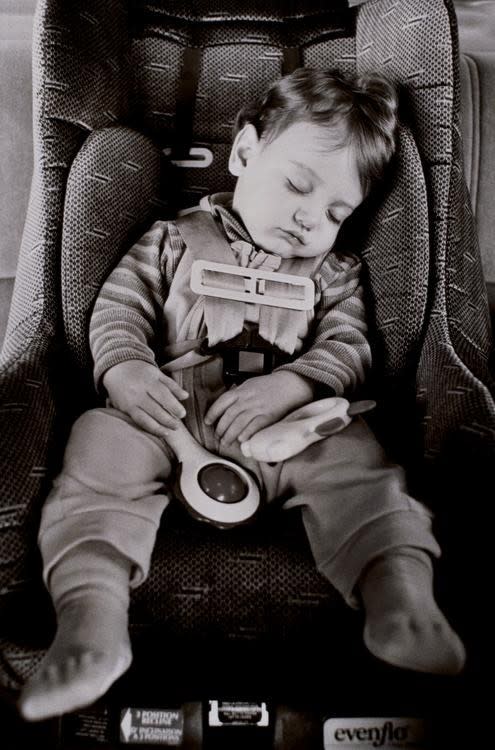How to Solve the Problem of Kids Getting Left in Hot Cars

Photo by Getty Images
The tragic case of Cooper Harris— the 22-month-old Georgia boy left to die in a sweltering SUV in June — has its own unique plot twists. But it’s still highlighted the massive problem of tots being forgotten in vehicles, where they are dying of heat stroke at alarming rates: At least 44 children died in 2013, according to data compiled by researchers at San Francisco State University. And so far this year that number is already up to 17. It seems like the kind of tragic situation that should be able to be prevented with a simple warning system — or at least a complex, technological one. But while such devices do exist, it turns out they’re just not all that lifesaving.
“Across different evaluations, the devices were inconsistent and unreliable in their performance,” concluded Kristy Arbogast, director of engineering for the Center for Injury Research and Prevention at the Children’s Hospital of Philadelphia, in a 2012 National Highway Transportation Safety Administration (NHTSA) report on such technologies. Still, while Arbogast has not reevaluated the products since then, she says there’s a problem with the basic nature of these devices — including a smart-phone-synched car seat, as well as wireless proximity sensors, both of which sound alarms when babies are left alone.
“The larger issue is that they are all child-restraint based technologies,” she tells Yahoo Health, meaning that parents are only alerted if the kids are buckled into their seats. “And while kids in their restraints represent a meaningful number of these tragedies, they don’t represent all of them.” In many other cases, for example, the children either entered an unlocked car to play and became trapped or were intentionally left in the car by caregivers running errands.
Related: 21 Ways to Keep Your Pets Safe All Summer
The NHTSA also downplays the power of such warning devices. “While technology-based reminders may prevent some instances, concerns about reliability and establishing a false sense of security lead us to believe eliminating these deaths requires education, vigilance, and personal responsibility,” the NHTSA said in a statement to Yahoo Health. It stresses that the best line of defense against hot-car tragedies is public education, and, to that end just launched its third year of “Where’s the Baby? Look Before You Lock,” a consumer-education and awareness campaign.
“Even great parents can forget a child in the back seat, but caregivers who are unaccustomed to transporting children are especially prone to forgetting,” the literature notes. It also offers facts about hot cars — that a car can heat up by 20 degrees in just 10 minutes, for example, that cracking a window does little to keep the car cool, and that a child’s body temperature can rise up to five times faster than that of an adult’s (with death assured with a temp of 107).
It also includes tips for how bystanders can help rescue a kid trapped a sweltering car — as was the case in both Texas and Georgia recently. “Don’t be afraid to act,” the campaign says, assuring that states have Good Samaritan laws to protect strangers from interfering during an emergency. “If the child is not responsive and appears in great distress,” it advises, “attempt to get into the car to assist the child, even if that means breaking a window.” Further, it notes, “If the child is in distress due to heat, get the child out of the car as quickly as possible. Cool the child rapidly (not in an ice bath) by spraying the child with cool water.”
Beyond the Good Samaritans, various citizens have been trying to help out the effort to prevent the deaths, too. In late June, North Carolina parent Terry Bartley uploaded his own “Hot Car Challenge” to YouTube, during which he sits in his car with the windows rolled up during an 80-degree day in order to raise awareness. “I want to know how it feels to be left in the car, sitting in the back seat, strapped into a car seat with the windows up and doors probably locked,” Bartley says in the video, which has since gone viral and inspired many others to try the same experiment.
Related: Photographer Documents Beloved Dog’s Final Day on Earth
Meanwhile, in Tennessee, 11-year-old Andrew Pelham won second place in an annual Rubber Band Contest for Young Inventors with his E-Z Baby Saver, an innovative device made of rubber bands and duct tape that attaches the driver’s car door to the back seat, stopping a caretaker in his or her tracks when they go to leave the vehicle. “I’m hoping if I can save one life with my invention, I can say that my invention was successful,” Pelham told Nashville’s News 2.
Arbogast believes the idea — like that of using other simple reminders, whether it’s putting your briefcase in the backseat or setting smartphone alarms — can help turn the number of tragedies around. It’s also important to keep something in mind: “It really can happen to anyone,” she says. “This is not about bad parenting or low socio-economic class, and it cuts across all levels of education. So awareness is really important, along with the technical piece.”

